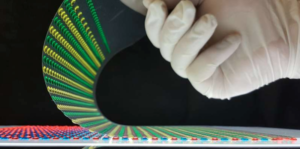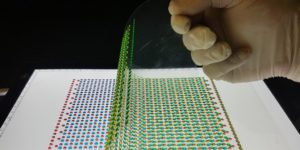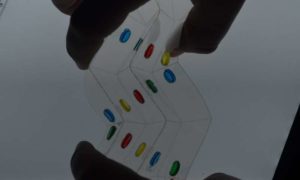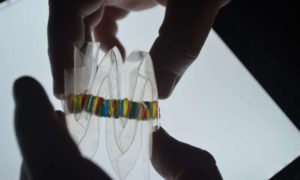 Electric eels are not evil, as much as Flotsam and Jetsam from The Little Mermaid would have you believe otherwise. The electric eel is the only species in its genus, and is able to generate short bursts of electric power to defend itself from predators and to zap its prey. This is due to a phenomenon known as a transmembrane transport – the eel has special electric organs that hold thousands of alternating compartments, filled with either sodium or potassium ions. Selective membranes keep the compartments separated when the eel is in its resting state, but also allow the ions to flow together, creating an electrical discharge of 100 watts, when the eel needs it.
Electric eels are not evil, as much as Flotsam and Jetsam from The Little Mermaid would have you believe otherwise. The electric eel is the only species in its genus, and is able to generate short bursts of electric power to defend itself from predators and to zap its prey. This is due to a phenomenon known as a transmembrane transport – the eel has special electric organs that hold thousands of alternating compartments, filled with either sodium or potassium ions. Selective membranes keep the compartments separated when the eel is in its resting state, but also allow the ions to flow together, creating an electrical discharge of 100 watts, when the eel needs it.
A collaborative team, made up of researchers from the University of Michigan (UM), the Adolphe Merkle Institute at the University of Fribourg, and UC San Diego, was inspired by the eel to develop a transparent, flexible electric device, using 3D bioprinting technology, that could one day lead to soft, biocompatible power sources, in the form of gel packs, for implanted health monitors, future cyborgs, and other applications.
Max Shtein, Associate Professor of Materials Science and Engineering at UM, said, “The eel polarizes and depolarizes thousands of cells instantaneously to put out these high voltages. It’s a fascinating system to look at from an engineering perspective—its performance metrics, its fundamental building blocks and how to use them.”
The work was funded by the Air Force Office of Scientific Research and the National Institute of General Medical Sciences of the National Institutes of Health, and detailed in a study, titled “An electric-eel-inspired soft power source from stacked hydrogels,” published in the most recent issue of Nature; co-authors include Thomas B.H. Schroeder, Anirvan Guha, Aaron Lamoureux, Gloria VanRenterghem, David Sept, Shtein, Jerry Yang, and Michael Mayer.
We’ve seen other 3D printing research that was inspired by marine animals, but this new work is unique in its focus on generating electricity on command. While the hydrogel-based tubular system the team created can’t generate near the amount of electricity the electric eel does, it’s a good step in further understanding how soft power sources work.
According to the abstract, “Here we introduce an electric-eel-inspired power concept that uses gradients of ions between miniature polyacrylamide hydrogel compartments bounded by a repeating sequence of cation- and anion-selective hydrogel membranes. The system uses a scalable stacking or folding geometry that generates 110 volts at open circuit or 27 milliwatts per square metre per gel cell upon simultaneous, self-registered mechanical contact activation of thousands of gel compartments in series while circumventing power dissipation before contact. Unlike typical batteries, these systems are soft, flexible, transparent, and potentially biocompatible.”
The team’s system uses the sodium and chloride found in common table salt, rather than sodium and potassium, and dissolved it in water-based hydrogel to make the synthetic soft cells which mimic an electric eel’s electrocyte cells. Then they 3D printed thousands of tiny droplets of the gel, using a special 3D bioprinter at the Adolphe Merkle Institute, onto a plastic sheet, and alternated them with hydrogel droplets of pure water, reminiscent of the eel’s special compartments.
In order to mimic the selective membrane that keeps the compartments separated, the researchers used another sheet of 3D printed alternating droplets, consisting of charge-selective hydrogel: each droplet allows either negatively charged chloride, or positively charged sodium, to pass through. The sheets are pressed together, connecting the freshwater and saline droplets across the charge-selective droplets in series. A steady buzz of low current, but high voltage, electricity is generated when the charge-selective droplets, as the solutions mix, move the chloride and sodium ions in opposite directions.
To solve the issue of combining the thousands of alternating ion cells at the same time, in the right order, the team looked again to the electric eel, which uses its compartments to instantaneously shuffle its ions when a coordinated jolt of energy is needed. Shtein, Guha, Schroeder, and Lamoureux turned to the Miura fold, an origami technique used to fold solar panels into satellites at launch. Once they’re in space, they are unpacked into large sheets.
In order to control the discharge of power from their system, the researchers reversed the idea of the fold, and alternated all four types of 3D printed droplets in a pattern onto a flat sheet laser-scored in a Miura pattern. The sheet folded together quickly when pressure was applied to it, which stacked the cells exactly where they needed to be to generate electricity.
“The electric organs in eels are incredibly sophisticated; they’re far better at generating power than we are. But the important thing for us was to replicate the basics of what’s happening,” said Mayer, a professor of biophysics at the Adolphe Merkle Institute.
Mayer believes that the team’s system could one day be used to power next-generation wearable and implantable devices, instead of bulky, toxic batteries; they won’t have to recharged quite as often, either. The technology is only in its preliminary stages now, and is not nearly efficient enough, but could even be used in cyborgs, which combine mechanical parts and living tissue, and bioelectric systems that generate electricity from the human body’s naturally occurring processes.
Let us know your thoughts; join the discussion of this and other 3D printing topics at 3DPrintBoard.com or share in the Facebook comments below.
[Sources: University of Michigan, University of Fribourg, TechXplore / Images: Thomas Schroeder and Anirvan Guha]
Subscribe to Our Email Newsletter
Stay up-to-date on all the latest news from the 3D printing industry and receive information and offers from third party vendors.
You May Also Like
3D Printing Unpeeled: New Arkema Material for HP, Saddle and Macro MEMS
A new Arkema material for MJF is said to reduce costs per part by up to 25% and have an 85% reusability ratio. HP 3D HR PA 12 S has been...
3D Printing News Briefs, January 20, 2024: FDM, LPBF, Underwater 3D Printer, Racing, & More
We’re starting off with a process certification in today’s 3D Printing News Briefs, and then moving on to research about solute trapping, laser powder bed fusion, and then moving on...
3D Printing Webinar and Event Roundup: December 3, 2023
We’ve got plenty of events and webinars coming up for you this week! Quickparts is having a Manufacturing Roadshow, America Makes is holding a Member Town Hall, Stratafest makes two...
Formnext 2023 Day Three: Slam Dunk
I’m high—high on trade show. I’ve met numerous new faces and reconnected with old friends, creating an absolutely wonderful atmosphere. The excitement is palpable over several emerging developments. The high...





































